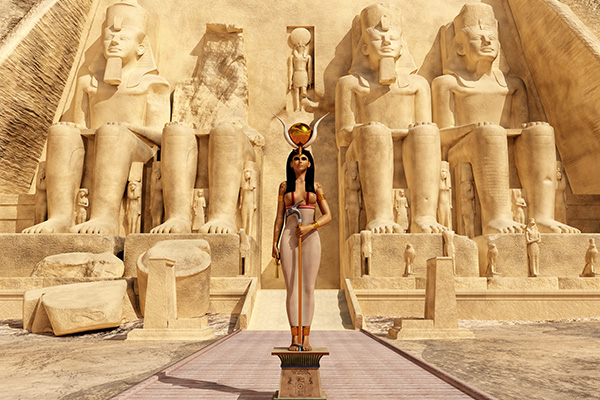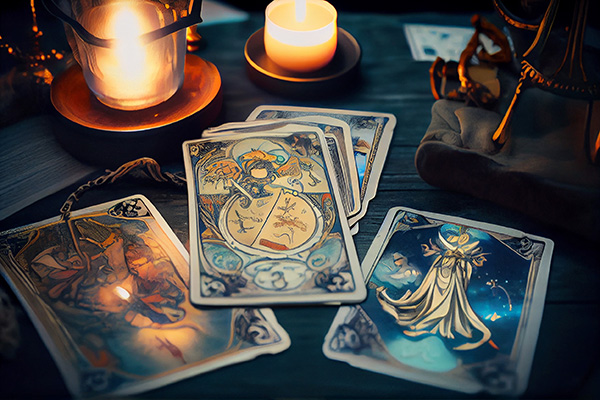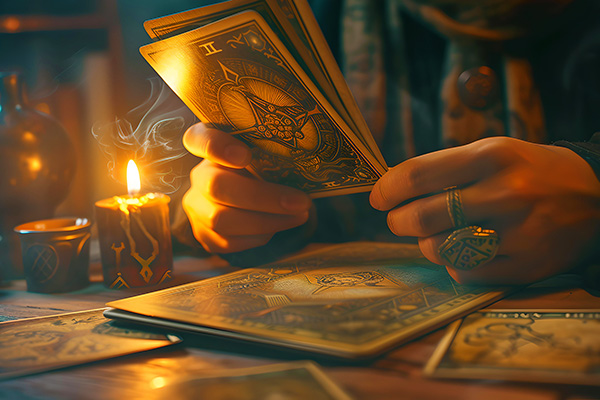What I Learned From Egyptian Goddess Hathor
 From the moment I first encountered her, Hathor, the ancient Egyptian goddess, she felt like a luminous companion on my spiritual path.
From the moment I first encountered her, Hathor, the ancient Egyptian goddess, she felt like a luminous companion on my spiritual path.
To me she isn’t just a myth or a symbol. She’s a living presence and a spiritual guide. She’s also a gentle yet powerful presence in my psychic and healing work. Her energy speaks to me on a deeply intuitive level.
My connection with Hathor began unexpectedly while reading a book on ancient Egypt. Suddenly, I felt a comforting warmth surround me. It was as if a long-lost friend had returned.
Then, I was guided to raise my hands, palms facing outward and I sensed her hands and palms facing mine. A glow of golden light flashed before me and I felt a warm sensation entering my palms and almost as though my hands were being supported and held, and all time was suspended.
In that timeless and powerful moment, Hathor’s nurturing love enveloped me, and her ancient wisdom whispered that time is merely a construct.
In the Infinite Light, there is no past or future, only this sacred now. In is in the present moment that healing and miracles unfold.
As a psychic, I find that Hathor naturally aligns with my practice. She is not just the goddess of love and beauty, though she radiates both. She embodies a vibrant, nurturing energy that opens emotional and spiritual channels.
How Psychic Readings Can Improve Your Intuitive Wisdom
 Have you ever had a clear inner knowing — a gut feeling you couldn’t quite explain — but you just knew it was real and true? Maybe it was a hunch about a person, a sudden feeling to take a different path, or a gut reaction that turned out to be right on the money.
Have you ever had a clear inner knowing — a gut feeling you couldn’t quite explain — but you just knew it was real and true? Maybe it was a hunch about a person, a sudden feeling to take a different path, or a gut reaction that turned out to be right on the money.
That quiet inner whisper was your intuition speaking, and it’s far more powerful and accurate than many people give it credit for. The good news is that this innate knowing isn’t just for the gifted few. Everyone has intuitive wisdom. It is a powerful compass that we all possess, and it grows stronger with use.
One very powerful way to develop your intuitive awareness is to work with a skilled psychic counselor to exercise your intuitive muscles, deepen your confidence, and expand your energetic awareness.
Think of a trusted psychic as a tuning fork for your soul. When they access insights that are just beyond your conscious reach — whether from energetic currents, symbols, impressions, or timelines-they create a resonant field that awakens and confirms what you may have already felt but couldn’t quite articulate.
That moment of “Yes! That rings so true!” is your inner knowing being recognized and validated. It’s not about the psychic telling you something new; it’s about reminding you of what your soul already knows.
In this way, psychic readings are not passive experiences. They’re deeply participatory. You’re not just a receiver of insight — you actively engage with your intuitive awareness. Over time, this engagement helps you recognize patterns: how your body responds to truth, how subtle feelings point you in the right direction, and how your dreams, synchronicities, and inner nudges have greater meaning than you may have realized.
Why Positive Affirmations Really Work
 You often hear spiritual people talk about using affirmations to improve their lives. Maybe you’ve seen quotes online or heard advice like, “Just repeat positive affirmations every day and watch your life change!”
You often hear spiritual people talk about using affirmations to improve their lives. Maybe you’ve seen quotes online or heard advice like, “Just repeat positive affirmations every day and watch your life change!”
But have you ever wondered what it really means? It sounds simple enough — but how can repeating a few positive statements really make such a big difference, especially when it comes to something as big (and sometimes complicated) as love and romance?
Let’s start at the beginning: What exactly are affirmations? Simply put, affirmations are short, powerful statements that you intentionally repeat to yourself, usually to create a positive shift in your thinking and mindset.
Affirmations are best phrased in the present tense — as if what you want is already true — to help “install” these intentions or beliefs in your subconscious mind and thus shift your energy. For example, “I am worthy of love,” “I am confident and magnetic,” or “I attract healthy, supportive relationships.”
At first, saying affirmations may feel a little strange or even wrong — especially if your current inner dialogue is filled with self-doubt or fear. But with consistent practice, something amazing begins to happen. You’re not just saying empty words-you’re literally rewiring your brain and shifting your energy to match what you want.
But how does it work? How can repeating just a few words every day change the way you attract love or make that special someone finally notice you? Let’s explore both the scientific and the magical, metaphysical aspects of affirmations and uncover why they work and how you can use them to seriously level up your love life!
Chakra Gemstones To Attract Love And Romance
 When it comes to love and relationships-whether you’re looking for a new connection, deepening the one you already have, or just feeling more naturally magnetic-understanding your own energy can make a real difference.
When it comes to love and relationships-whether you’re looking for a new connection, deepening the one you already have, or just feeling more naturally magnetic-understanding your own energy can make a real difference.
Working with crystals and gemstones can help enhance and shift your energy in subtle ways, shaping not only how you connect with others, but also who you attract into your life.
Sometimes we focus so much on what’s happening outside of us-what someone said, how they acted, how they feel-that we forget that the most powerful influences often come from within. When our energy is balanced, clear and aligned with love, everything around us begins to reflect that.
Crystals and stones can be friendly allies, offering a little extra support and encouragement as you navigate the ups and downs of love. They’re not magic fixes, but they can gently help you stay centered, open-hearted, and in tune with the kind of love you truly deserve.
The more you consciously work with these stones, the more you’ll notice subtle changes: feeling more confident, radiating more warmth, or simply being in the right place at the right time to meet someone special.
By making love crystals a part of your daily spiritual practice and lifestyle, you will soon begin to notice people responding differently, new opportunities for connection, or even a deeper sense of self-love that changes the way you experience relationships altogether.
The Tarot Is A Mystical Bridge To Spiritual Insight
 Mysterious, symbolic and highly energetic, the Tarot is a high vibrational tool that can help us explore the deeper meaning behind the events of our daily lives, and the influence of Spirit in our earthly existence.
Mysterious, symbolic and highly energetic, the Tarot is a high vibrational tool that can help us explore the deeper meaning behind the events of our daily lives, and the influence of Spirit in our earthly existence.
The Tarot especially offers guidance in situations where may feel lost or confused, and it serves as a mystical bridge between our physical reality and the metaphysical realm.
The cards have their own energy, a high vibrational frequency, which Spirit uses to communicate messages of guidance, encouragement, insight and caution.
Every Tarot reader has their own set of spiritual gifts and psychic abilities, and therefore we tend to each develop our own reading style accordingly.
In my own readings, I find that Spirit most often seeks to illuminate areas in our lives where changes and healing may be needed, in order to bring about the most beneficial future outcomes. This can be anything from the need to shift one’s perspective, to the need to let go, or sometimes the need to simply accept things as they are.
Ultimately, I find Spirit uses the Tarot to get us ‘unstuck,’ so we get back in the flow. When we are in the flow, or in alignment, we are creating with the Universe, instead of creating resistance. Only then are we truly moving toward our highest good and the fulfillment of our greatest potential.
The Tarot is a conduit for communication with our guides and our higher self, through which we can gain a deeper understanding of the soul lessons and the magic happening in our lives.
Finding Peace and Joy In The ‘No-thingness’
 Like Neo in the movie The Matrix (1999) our minds occasionally slip into luminous moments of complete stillness and clarity — tiny mental pauses where all thinking stops just long enough for us to glimpse the truth of all existence.
Like Neo in the movie The Matrix (1999) our minds occasionally slip into luminous moments of complete stillness and clarity — tiny mental pauses where all thinking stops just long enough for us to glimpse the truth of all existence.
In these fleeting spaces between our thoughts, it becomes clear that the comings and goings of life are just that… temporary ‘blips’ of experience that arise and pass through our awareness.
I have come to know these moments as realizations of ‘no-thingness.’
In these brief pauses, something quietly opens up within us. We notice the obvious — what has always been there — hidden behind the busy waking mind and its constant commentary. Our awareness shifts from being consumed by temporary events to seeing what’s always there: the background, the container, the eternal.
These silent mental breaks reveal something much deeper and greater than our own existence and awareness.
There’s a word for this in ancient Sanskrit: svabhāva. It means one’s true nature — the essence of who we are beneath the roles, stories, and conditioning. The term is used in many yogic and Vedantic texts to describe the innate reality or unconditioned self beyond our human ego and thoughts.
Our true authentic self is not something we become. It’s something we remember. When we glimpse the silence between thoughts, we’re not discovering something new — we’re reconnecting with our original divine self. Not the self that reacts and worries, but the self that simply is. Svabhāva is the part of us that doesn’t come and go. It’s the constant presence behind every changing moment. It is the essence of living a truly conscious life.

